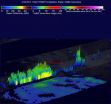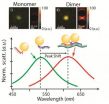(Press-News.org) This news release is available in French and Spanish.
Montreal, 23 April 2014—Today, the CEC released its Conservation Assessment for the Big Bend-Río Bravo Region: A Binational Collaborative Approach to Conservation, which identifies 29 priority conservation areas in a region straddling the United States-Mexico border that includes 11 different protected areas in the states of Texas, Coahuila, and Chihuahua. This region features unique, highly diverse arid and semi-arid habitats inhabited by rare and endangered plants and animals, and provides a vital migratory stopping point for many species of birds and animals on their journey across the continent.
The improved resilience for this area of North America that will result from the implementation of the recommendations of the Assessment is being celebrated by the CEC as part of its 20th anniversary. The cooperative, multi-stakeholder approach used to identify conservation priorities in the Big Bend-Río Bravo region included scientists, government experts, private landowners, and communities and is symbolic of the CEC's 20 years of collaborative work on a wide array of environmental policy issues.
Taking input from those who live and work in the Rio Grande region, along with advice from outside experts, the Assessment identifies conservation targets for, and threats to, the grassland, mountainous, aquatic, and riparian habitats of this vast transboundary landscape, including the Rio Grande itself. Drawing from the recommendations and priorities identified in the Assessment for the region, the CEC is supporting restoration and monitoring actions in selected tributaries and a landscape-wide monitoring program throughout the region.
Recommendations of the Assessment:
Protect environmental quality and promote sustainable economic development of border communities, including the development of binational ecotourism routes on both sides of the US-Mexico border;
Develop conservation strategies that will preserve an ecosystem that is resilient to climatic changes;
Build capacity within academia, state and federal agencies, as well as within civil society to conduct the recommended inventories, monitoring, and research in each of the 29 priority conservation areas identified;
Create an institutional framework to facilitate binational conservation and restoration projects in the region; and
Support and justify funding at the international, national, and local levels in both Mexico and the United States.
The Assessment's ultimate goals are to:
Establish a common frame for discussing transboundary protection of natural resources in the region;
Assist all who live and work in the region in identifying opportunities for improving conservation practices;
Create or maintain ongoing collaborative conservation projects across the Big Bend-Río Bravo landscape;
Serve as a model for transboundary conservation efforts that can inform similar initiatives across North America, including in Canada.
Quick fact:
When Big Bend National Park was established on 12 June 1944, President Franklin D. Roosevelt of the United States of America wrote to President Manuel Ávila Camacho of Mexico, "I do not believe that this undertaking in the Big Bend will be complete until the entire park area in this region on both sides of the Rio Grande forms one great international park." Seventy years later, the pace of the current binational efforts picked up in 2010, with a statement from the US and Mexican governments to "work through appropriate national processes to recognize and designate Big Bend–Río Bravo as a natural area of binational interest."
INFORMATION:
For more information, please contact project coordinator Catherine Hallmich: challmich@cec.org
About the CEC
The Commission for Environmental Cooperation (CEC) is an intergovernmental organization that supports the cooperative environmental agenda of Canada, Mexico and the United States to green North America's economy, address climate change by promoting a low-carbon economy, and protect its environment and the health of its citizens. The CEC is composed of three bodies: a Council, representing the governments of the three member countries, a Joint Public Advisory Committee (JPAC) that advises the Council and serves as a liaison with the public, and a Secretariat that supports the Council and JPAC and prepares independent reports. The CEC brings together governments, civil society, and businesses to develop innovative North American solutions to global environmental challenges. Find out more at: http://www.cec.org.
CEC initiatives are undertaken with the financial support of the Government of Canada through the federal Department of Environment, the Government of the United States of America through the Environmental Protection Agency, and the Government of the United States of Mexico, through the Secretaría de Medio Ambiente y Recursos Naturales.
Conservation priorities released for several protected areas along US-Mexico border
The Commission for Environmental Cooperation releases the Big Bend-Rio Bravo Conservation Assessment, the latest result of over 20 years of environmental cooperation in North America
2014-04-23
ELSE PRESS RELEASES FROM THIS DATE:
Novel compound halts cocaine addiction and relapse behaviors
2014-04-23
BUFFALO, N.Y. – A novel compound that targets an important brain receptor has a dramatic effect against a host of cocaine addiction behaviors, including relapse behavior, a University at Buffalo animal study has found.
The research provides strong evidence that this may be a novel lead compound for treating cocaine addiction, for which no effective medications exist.
The UB research was published as an online preview article in Neuropsychopharmacology last week.
In the study, the compound, RO5263397, severely blunted a broad range of cocaine addiction behaviors.
"This ...
NASA sees last vestiges of Tropical Depression Jack
2014-04-23
Tropical Cyclone Jack had weakened to a tropical depression when NASA and JAXA's Tropical Rainfall Measuring Mission (TRMM) satellite passed above on April 22, 2014 at 1120 UTC/7:20 a.m. EDT.
At that time, TRMM found that Jack was devoid of almost all rainfall near the tropical cyclone's center. Outside the center was a different story, however. That's where TRMM's precipitation radar instrument found rain falling at a rate of over 130mm/hr (about 5.1 inches) in a band of thunderstorms that stretched from east of Jack's center to the south. Some of the thunderstorms even ...
EARTH Magazine: Faking quakes at full scale
2014-04-23
Alexandria, Va. – On a muggy day in mid-July 2009, a lone seven-story condominium complex northwest of Kobe, Japan, was violently shaken by an earthquake. Onlookers watched the 23-unit, wood-frame tower sway and bounce while, inside the building, furniture toppled and plates clattered to the floor. No one was hurt during the highly localized event and there was only minimal damage, in part because the building's wooden skeleton had been augmented to better resist earthquake shaking, but also because the whole event — from the seismicity to the partially furnished building ...
Some astronauts at risk for cognitive impairment, animal studies suggest
2014-04-23
Johns Hopkins scientists report that rats exposed to high-energy particles, simulating conditions astronauts would face on a long-term deep space mission, show lapses in attention and slower reaction times, even when the radiation exposure is in extremely low dose ranges.
The cognitive impairments — which affected a large subset, but far from all, of the animals — appear to be linked to protein changes in the brain, the scientists say. The findings, if found to hold true in humans, suggest it may be possible to develop a biological marker to predict sensitivity to radiation's ...
Gold nanoparticles help target, quantify breast cancer segments in a living cell
2014-04-23
WEST LAFAYETTE, Ind. - Purdue University researchers have developed a way to detect and measure cancer levels in a living cell by using tiny gold particles with tails of synthetic DNA.
A team led by Joseph Irudayaraj, professor of agricultural and biological engineering, used gold nanoparticles to target and bind to fragments of genetic material known as BRCA1 messenger RNA splice variants, which can indicate the presence and stage of breast cancer. The number of these mRNA splice variants in a cell can be determined by examining the specific signal that light produces ...
Study identifies enzymes that help fix cancer-causing DNA defects
2014-04-23
Purdue University researchers have identified an important enzyme pathway that helps prevent new cells from receiving too many or too few chromosomes, a condition that has been directly linked to cancer and other diseases.
Mark Hall, associate professor of biochemistry, found that near the end of cell division, the enzyme Cdc14 activates Yen1, an enzyme that ensures any breaks in DNA are fully repaired before the parent cell distributes copies of the genome to daughter cells. This process helps safeguard against some of the most devastating genome errors, including the ...
A key to enjoying massive online photo files may be giving up some control
2014-04-23
PITTSBURGH—The ability of individuals to store and instantly access thousands of their photos online has become a commonplace luxury, but the sheer size of these archives can be intimidating. Researchers at Carnegie Mellon University and Microsoft Research Cambridge, UK, have found people might actually enjoy their collections more by giving up a bit of control and learning to wait.
Their 14-month study showed that people reflected more on past events and developed a renewed interest in their online photos when a device called Photobox would randomly print four or five ...
AGU: Odds of storm waters overflowing Manhattan seawall up 20-fold, new study shows
2014-04-23
WASHINGTON, D.C. -- Maximum water levels in New York harbor during major storms have risen by nearly two and a half feet since the mid-1800s, making the chances of water overtopping the Manhattan seawall now at least 20 times greater than they were 170 years ago, according to a new study. Whereas sea-level rise, which is occurring globally, has raised water levels along New York harbor by nearly a foot and a half since the mid-19th century, the research shows that the maximum height of the city's "once-in-10-years" storm tide has grown additionally by almost a foot in that ...
Study finds long-term survival of human neural stem cells transplanted into primate brain
2014-04-23
Putnam Valley, NY. (Apr. 23 2014) – A team of researchers in Korea who transplanted human neural stem cells (hNSCs) into the brains of nonhuman primates and assessed cell survival and differentiation after 22 and 24 months found that the hNSCs had differentiated into neurons at 24 months and did not cause tumors.
The study will be published in a future issue of Cell Transplantation but is currently freely available on-line as an unedited early e-pub at: http://www.ingentaconnect.com/content/cog/ct/pre-prints/content-ct1117Antonucci2.
The hNSCs were labeled with magnetic ...
Scientists identify source of mysterious sound in the Southern Ocean
2014-04-23
Scientists have conclusive evidence that the source of a unique rhythmic sound, recorded for decades in the Southern Ocean and called the "bio-duck," is the Antarctic minke whale (Balaenoptera bonaerensis). First described and named by submarine personnel in the 1960s who thought it sounded like a duck, the bio-duck sound has been recorded at various locations in the Southern Ocean, but its source has remained a mystery, until now.
In February 2013, an international team of researchers deployed acoustic tags on two Antarctic minke whales in Wilhelmina Bay off the western ...
LAST 30 PRESS RELEASES:
Targeting specific protein regions offers a new treatment approach in medulloblastoma
$2.7 million grant to explore hypoxia’s impact on blood stem cells
Cardiovascular societies propel plans forward for a new American Board of Cardiovascular Medicine
Hebrew SeniorLife selected for nationwide collaborative to accelerate system-wide spread of age-friendly care for older adults
New tool helps identify babies at high-risk for RSV
Reno/Sparks selected to be part of Urban Heat Mapping Campaign
Advance in the treatment of acute heart failure identified
AGS honors Dr. Rainier P. Soriano with Dennis W. Jahnigen Memorial Award at #AGS24 for proven excellence in geriatrics education
New offshore wind turbines can take away energy from existing ones
Unprecedented research probes the relationship between sleep and memory in napping babies and young children
Job losses help explain increase in drug deaths among Black Americans
Nationwide, 32 local schools win NFL PLAY 60 grants for physical activity
Exposure to noise – even while in the egg – impairs bird development and fitness
Vitamin D availability enhances antitumor microbes in mice
Conservation actions have improved the state of biodiversity worldwide
Corporate emission targets are incompatible with global climate goals
Vitamin D alters mouse gut bacteria to give better cancer immunity
Escape the vapes: scientists call for global shift to curb consumer use of disposable technologies
First-of-its-kind study definitively shows that conservation actions are effective at halting and reversing biodiversity loss
A shortcut for drug discovery
Food in sight? The liver is ready!
Climate change could become the main driver of biodiversity decline by mid-century
Voluntary corporate emissions targets not enough to create real climate action
Curiosity promotes biodiversity
Warming Arctic reduces dust levels in parts of the planet
New MSU research finds paid family leave helps prevent child abuse
Endocrine Society names Andrews as new Editor-in-Chief of Endocrinology
Type of surgery and its risk level has significant impact on complications and death in elderly patients
National Center to Reframe Aging teams up with Longevity Ready Maryland Initiative
Study reveals racial disparities in COVID-19 testing delays among healthcare workers
[Press-News.org] Conservation priorities released for several protected areas along US-Mexico borderThe Commission for Environmental Cooperation releases the Big Bend-Rio Bravo Conservation Assessment, the latest result of over 20 years of environmental cooperation in North America





